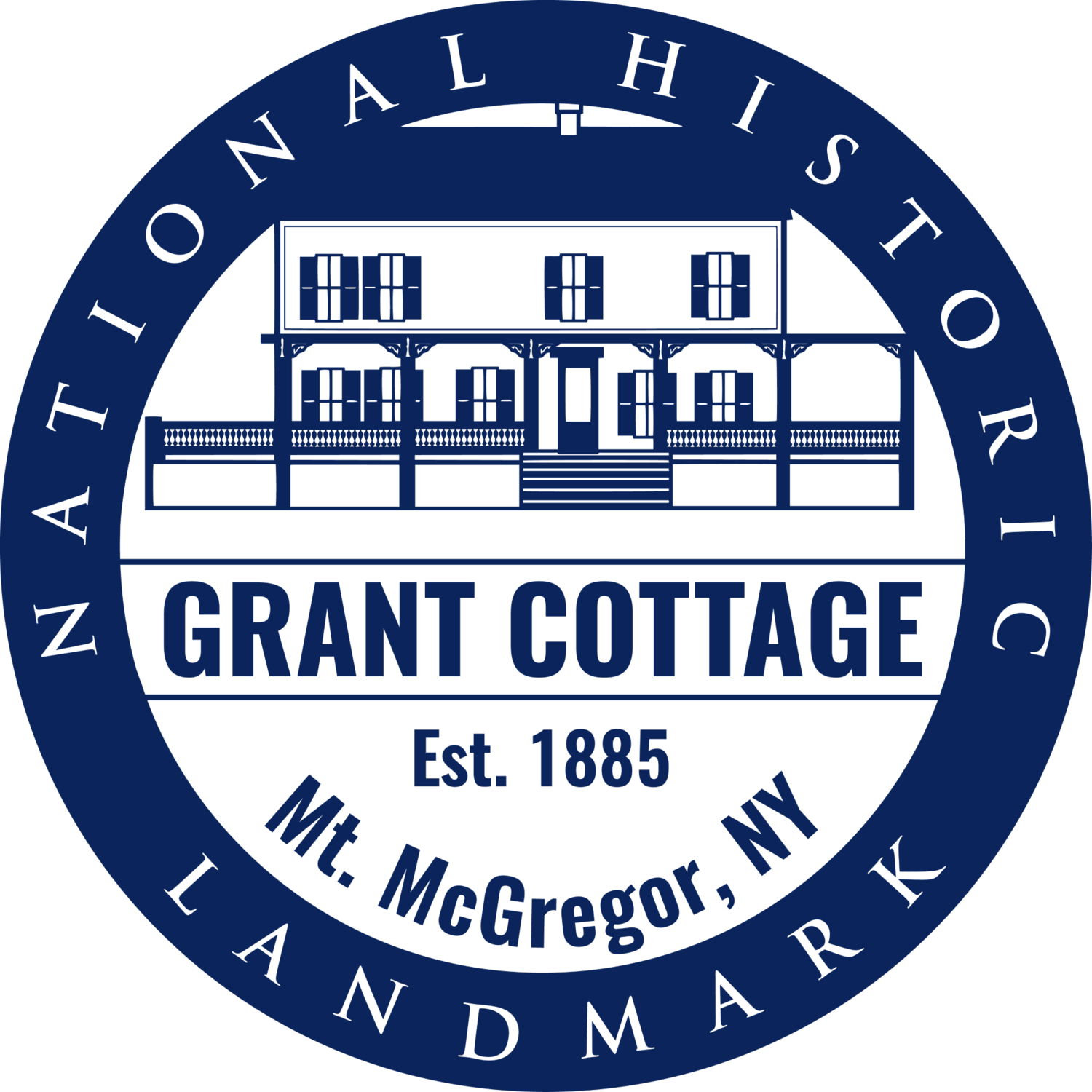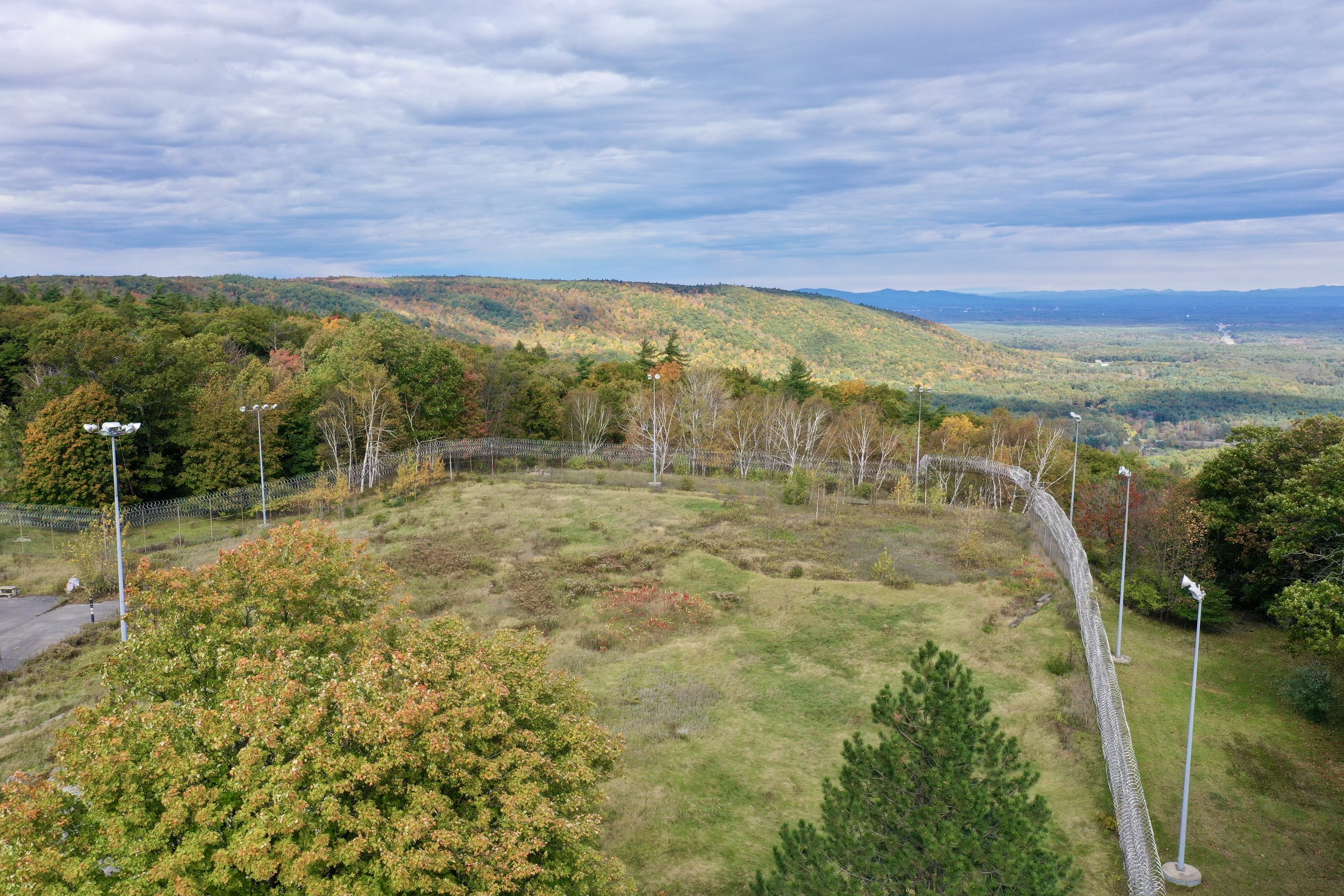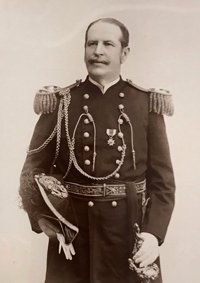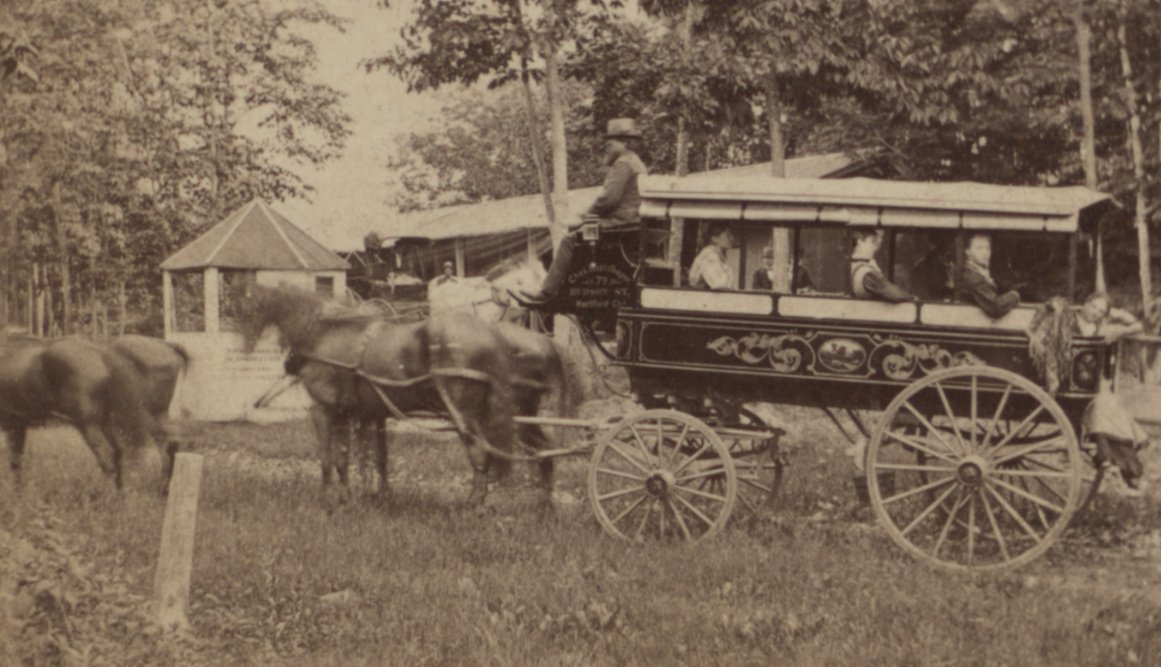McGregor’s Vision
Modern view of the “Field of Dreams” on Mount McGregor.
“If you build it, they will come” is an ancient concept made more popular in modern times by the feature film Field of Dreams starring Kevin Costner. The concept is that with sufficient creativity, effort and promotion one can create an enterprise that will successfully draw visitors. In the fall of 1872 in a mountaintop field, a man’s bold vision would draw hundreds to that location, all anxious to see his new enterprise become a success. It would become a place of community, hosting hundreds of thousands over the next century and a half. The uses of the field and those that visited would change dramatically over the years but the beauty of the place and its role as a place of community would remain constant. From a luxurious Victorian-era hotel to a baseball diamond and playground, the place was the scene of constant activity until 2014. In that year the Mt. McGregor Correctional Facility closed leaving the fenced in parcel devoid of human presence for the next eight years. As nature began reclaiming the field with trees and shrubs, there was a certain sadness to the empty field sitting only steps from the Grant Cottage Historic Site. The Historic Site thrived throughout those years and a need for expansion became evident. All eyes, as they were 150 years before, are turned towards the field of dreams, a place of history, of natural beauty and of promise. A place that could once again bring visitors together in community to enjoy the mountains’ history and charms. With the recent transfer of the four acre field to the Historic Site, those involved with the Historic Site are now hearing the words clearly “If you build it, they will come.” In order to fully appreciate the history and the potential of the property one must look at its’ origins and storied past.
Before there was a Mount McGregor there was what was known as Palmertown Mountain. This mountain was part of the foothills of the Adirondack Mountains rising steeply out of the upper Hudson River valley in the townships of Wilton, Corinth and Moreau. A colossal ancient pine stood near the high point that of the mountain and served as a landmark to those living and traveling in the valley below. After centuries of Native American hunting, trade and colonial conflict, a period of peace came to the area by the mid-19th century. Duncan McGregor, the son of Scottish immigrants, was raised in a home in the shadow of the mountain during this time. Undoubtedly as a boy he explored the steep ridges and viewpoints behind his family home, perhaps even treading upon the very ground that would later be part of his great inspiration.
Palmertown Mountain (Mt. McGregor) from Wilton, New York.
1866 map showing Duncan McGregor’s property on Palmertown Mountain (Mt. McGregor).
McGregor was a successful businessman by the end of the Civil War, owning multiple enterprises in the area. There is a story that a vacationer in nearby Saratoga Springs ascended Palmertown Mountain, was enthralled by the setting and views, leading him to suggest to McGregor that he develop the mountain for the public. Perhaps McGregor heard a version of the refrain “If you build it, they will come” and by the late 1860’s he acquired large parcels of property on Palmertown Mountain. Things moved slowly at first with crude forest roads and some logging operations the only signs of progress. By the fall of 1871 the papers began to cover operations and plans for improvement on the mountain by McGregor and his partners. A right-of-way was secured to construct a road to a “summer hotel” to be known as the “Mountain House.” There can be no doubt that the news of this proposed mountaintop resort drew significant interest from the small rural communities surrounding the mountain as well as the nearby resort towns of Saratoga Springs and Lake George. Arrangements were made to relocate a sawmill operation to the site to begin improvements.
Anticipation would build over the next year and as the cool breezes of the late summer of 1872 descended on the area plans were being made to have a great community picnic on the summit. The picnic was being organized by representatives from many local communities to celebrate the opening of McGregor’s new road up the mountain. One of the organizers, Civil War veteran and local pastor Reverend Robert G. Adams, went to see Mr. McGregor about the event. During their discussion, later retold by Rev. Adams, the mountain received its new name:
Reverend Robert G. Adams (1839-1916)
““I asked him what name he was intending to give the mountain. He said he had not yet thought of that, and I asked if I might have the privilege of naming it. He replied, ‘I had just as soon you would name it as anybody, in fact I had rather you would.’ Then he said to me, ‘What would you call it?’ I replied ‘Mount McGregor.’ He said, ‘I am pleased with that and that shall be the name, unless a few capitalists from New York who are interested in the enterprise should desire to name it.’”
Thus, Mount McGregor was born and would open in rather spectacular fashion. On September 18, 1872, a steady stream of carriages ascended the freshly created winding and steep mountain road. Excited picnic-goers passed under a large America flag and an arch of evergreens and flowers with the words “WELCOME!” on their journey of discovery.
Upon reaching the summit, trees had been cleared to create picnic grounds with tables set up in a hollow square with dramatic views of the valley and the sounds of the Glens Falls Band to liven up the festivities.
The traumatic Civil War had ended only seven years before and those in attendance were eager to embrace the peace. Ex-Congressman William Sackett who had lost his son William during General Grant’s Overland Campaign of 1864, spoke of the importance of community and progress. He highlighted the necessity of working together to build a better, more productive future for the Saratoga region and commended Mr. McGregor for his vision to create a mountain resort.
Next to speak was 35-year-old George Batcheller, a Civil War veteran and New York State Assemblyman who would later be appointed to a post in Egypt by President Ulysses Grant. Batcheller, who would eventually establish his “Mansion” on South Broadway in nearby Saratoga Springs, reinforced the importance of coming together in fellowship and peace during his brief remarks.
The secret of Mt. McGregor was out as a reporter at the event recorded:
“From an opening which has been cleared away in the thick forest that covers the summit a delightful view is afforded of a wide region of country…. We had no idea that from any place in Saratoga County so extended and pleasing a mountain view could be obtained, it is a sight which one may sit and enjoy for hours or days, or even weeks, and never tire. Hereafter let it not be said by our summer guests that Saratoga lacks in the picturesque, for a drive of an hour and a half will place them on the topmost height of Mt. McGregor, a spot beautiful and picturesque in itself, with the purest of air and the coolest of breezes.”
A view of the countryside from Mt. McGregor.
The picnic goers as they enjoyed their meal and the late summer mountain breezes must have been envisioning the new resort. McGregor revealed his plans for a hotel near the site of the picnic to be known as the “Saratoga Mountain House.” The picnickers marveled at the base of the great summit pine with many names carved on it that had been broken off during a storm the previous winter. In a way the demise of this “monarch of the forest” was a symbol of one era ending and a new beginning for the summit of the mountain.
The next year in the mountain’s history is mostly lost to the mists of time, but a large Sunday School picnic occurred on the summit in the fall of 1873. Reverend Walter Doe, who had been born and raised in the shadow of the mountain, spoke to the hundreds in attendance of his childhood memories. Though Doe had lived in multiple places for schooling and pastoring, the mountain obviously held a special place in his heart. The mountain seems to influence many who visit and makes them want to linger. Perhaps the magic of the mountaintop is different for different people, but it does have an inexorable draw for many who have stepped foot on its heights. Many, such as Reverend Doe, who once spent time on Mt. McGregor have returned to recall their pleasant memories of the mountain.
As Duncan McGregor started to build his resort, visitors continued to venture up the steep mountain road to the alluring summit. In late August 1874 a sizeable Sunday School parade took place on the mountain road:
“The Wiltonville [Sunday] School led, headed by a band of martial music… and thirty young men on horseback with regalia and badges… It was a grand sight to see over two hundred wagons trimmed, and some bearing motoes worthy of notice, winding their way through the forest. We soon came to the summit and found the lord of the domain in waiting, who gave us a hearty welcome to the land of Mt. McGregor.”
In such a place of inspiration, Sunday School children recited their poetry, the choir sang, and the band played. The individual reporting the event once again encouraged others to visit such a special place, “I would advise all that could conveniently to visit Mt. McGregor. Its magnificent scenery and bracing air are worthy of attention.”
Victorian visitors enjoying the views from Mt. McGregor.
The mountain continued to attract visitors through the romantic descriptions given by correspondents to the newspapers. One correspondent described the views as “the grandest and most surprisingly beautiful pictures to be seen on earth” and said visitors would surely “be haunted by the entrancing vision night and day for a whole month at least” place as providing “soul-thrilling inspiration, that lofty and purifying love of the grandly beautiful.” To this correspondent the hour and a half carriage journey up the mountain from Saratoga Springs was well worth it and that planned enhancements such as a hotel and improved roads would make it an even more attractive excursion.
1874 is the year that the earliest buildings of McGregor’s modest mountain destination are first revealed in a stereoview card by well-known local photographer Seneca Ray Stoddard. Stoddard, who was born near Mount McGregor, photographed a modest two-story frame structure with an attached single-story dining room titled “Mount McGregor House.” Another image likely taken at the same time captures the interior view of the small dining room. The location of the buildings in the woods was important to provide shade to guests of the mountain, especially when there were no porches for cover.
Seneca Ray Stoddard stereoview card depicting Mt. McGregor buildings in 1874.
A close up of the Stoddard steroview image. Note the attached dining room on the front of the building.
Mt. McGregor dining room interior. (Trombley-Prosch Collection)
While a modest number of visitors were making excursions to the mountain, Mr. McGregor was busy expanding. A “new hotel” was being built and was planned to be open by the following year. A visitor described the progress in November of 1875:
“we paid a visit to the place and were surprised at the improvements that have been made within a year… A new hotel has been erected by him and is now completed. The house is pleasant and attractive, and the health as well as the comfort of the guests has received attention, the ceilings being high and the rooms commodious. The kitchen is separate from the hotel proper thus avoiding the commotion and heat incident thereto. Mr. McGregor intends getting furniture and will formally open the house in the spring with a "house warming." There is a trout pond a short distance from the house and game is very abundant. Most all the rooms have been engaged for next season…”
Artists Lake on Mt. McGregor from a stereoview image. ca. 1870’s-1880’s
The trout pond mentioned is undoubtedly Artists Lake which was only 300 yards south of McGregor’s new hotel. Having a mountain pond with a rocky shore nearby only added to the charm of the place.
A forest fire threatened the mountain in April of 1876 but the fledgling resort and its new structures were spared. The new hotel with a separate dining hall opened on July 1st and it was reported that Mr. McGregor had “fitted up the grounds in fine style.” It was taking some time but Mr. McGregor’s dream for the mountain was gradually becoming a reality and it was finally on the map, literally.
1876 map showing “Mt. McGregor.” (Note the townships of Corinth, Wilton and Moreau meet on the mountain.)
McGregor was not alone in his enterprise, his niece Caroline and her husband James Sprott were involved. Caroline’s death at Mt. McGregor in early 1877 at only 38 years of age did not deter her uncle from continuing to develop the resort. Perhaps honoring her memory even served as motivation to both men as her obituary stated that the moss parterre gardens she created on the mountain were a “sweet memorial of her whose hands were folded for the rest of the grave before the improvements were complete.” Nearby Lake Ann (now within Moreau Lake State Park) was named for Caroline’s daughter Anna who remained a part of the McGregor household.
Lake Ann from a sereoview image. ca. 1870’s-1880’s
“Mossy mound on Mount McGregor” stereoview image. ca. 1870’s-1880’s
The mountaintop’s tradition as an outdoor community gathering place continued and Mr. McGregor was always a generous and gracious host. A Sabbath school picnic numbering 150 individuals picnicked on the mountain in the fall of 1877 stating that “The day was happily spent, all present voting Mount McGregor as one of the best places in this section to hold a picnic.” One grateful mountain visitor described the scene of the fledgling resort in poetic terms:
“Till at the Mountain House we find a rest,
And every comfort greets the coming guest.
Here, broad piazzas overlook the scene
In part – the distance and the vast between;
While winding pathways through the forest round,
And rustic seats throughout the groves are found…
Now Mr. McGregor…thanks for this pleasure we send to you:
For bringing to note a magnificent site.”
1878 advertisement for Mt. McGregor.
Another feature of the place besides the views, rustic charm and coolness was evident from the earliest descriptions, it was advertised as a destination for health. The theme of health would intermingle with that of community and recreation over the next 140 years on the mountain. One article says the mountain offers to the visitor “the healing balm of pure air, pollen poison free, air medicated by the pines, poured into his lungs, he forgets all his ailments…” Frequently it was stated that sufferers of hay-fever were staying on the mountain for relief.
Fine meals featuring fresh garden produce and local game was frequently mentioned. Amusements on the mountain at this time included walking paths, croquet, boating, fishing as well as games of cards and music in the evenings. Most were there to seek rest and relaxation and were content to sit and gaze on the tremendous views of the active valley life below. This sense of being “above it all” would bring the sensation of escape and freedom to visitors.
Omnibus carriages, similar to the one pictured, brought visitors up Mt. McGregor for a $1.00 roundtrip fare.
A glimpse of the summit conditions is related in the History of Saratoga County, New York published in 1878:
“The buildings occupy the crowning summit a short distance above the ‘lookout.’ They are surrounded by a second growth of timber, — pine, chestnut, oak, beech, maple, and birch, trimmed and cleared of underbrush. This affords ample room for croquet-grounds, swings, and winding walks outlined with whitened stones, affording a peculiarly striking appearance by moonlight.”
Talk of expansion included more room for guests (only about 20 could be accommodated at the existing hotel), the erection of cottages on the resort grounds, a viewing tower, more carriage roads and telegraph service. McGregor continued to expand having an arch built to greet visitors coming to the mountain stating “Mount McGregor, one mile and a half” and expanded the carriage trail network. 1880 would bring more talk of improvements including telephone and rail service to the mountain. Although McGregor accomplished expanding the lodging by building a two-story structure onto the older of two dining halls in 1881, he was now a recent widower in his early 70’s. Perhaps he was feeling the years and his stamina to run the enterprise was running lower. It seemed as though the time may be right to pass the torch, to have others carry on the vision. The man of vision had seen his dream become a reality though, with an estimated 8000 visitors reported on Mt. McGregor in 1881. McGregor remained involved with the mountain for a few more years and continued with his other successful business and civic efforts, but his time as the leader of the mountaintop enterprise was over. His vision for the mountain however, is forever enshrined in the name itself and the thousands that continue to visit the mountain every year.
A glimpse of the view northeast that enchanted visitors to the “Field of Dreams” in the 19th century.
Sources:
The Daily Saratogian, Oct. 7, 1871, Sept. 19, 1872, Sept. 4, 1873, Sept. 3, 1874, March 28, 1876, July 23, 1877, Sept. 21, 1877
The Daily Graphic (NY), Sept. 5, 1878
The Saratogian, Sept. 19, 1878
The Oneida Dispatch, Sept. 18, 1874
The Pittsburg Daily Post, Aug. 2, 1878
The Weekly Saratogian, Aug. 8, 1880
The Saratoga Sentinel, Dec. 16, 1880
The Brooklyn Daily Eagle, July 18, 1883
Rev. Robert G. Adams Sept. 28, 1915
The Captain Departs by Thomas M. Pitkin
History of Saratoga County, New York by Nathaniel B. Sylvester






















